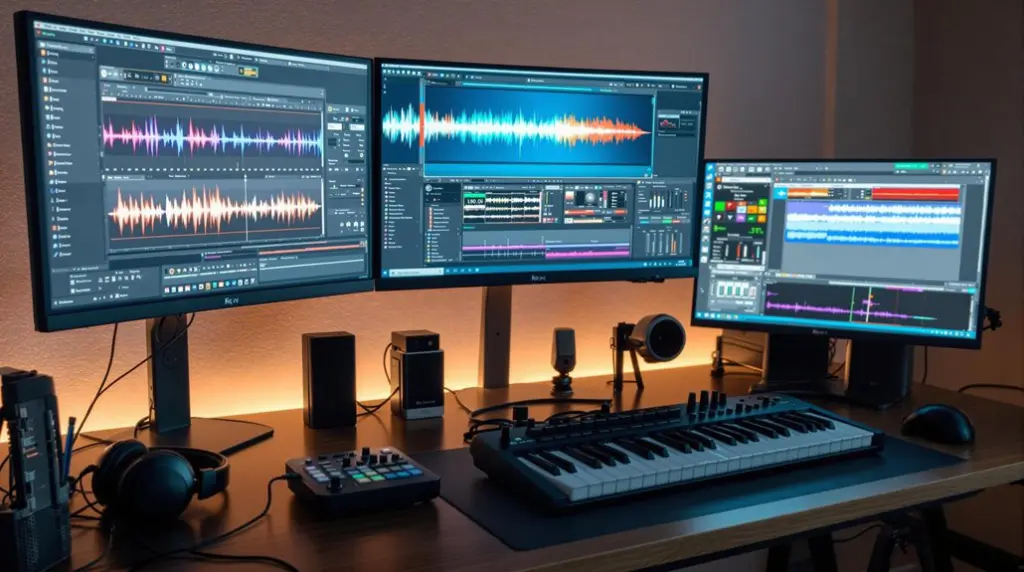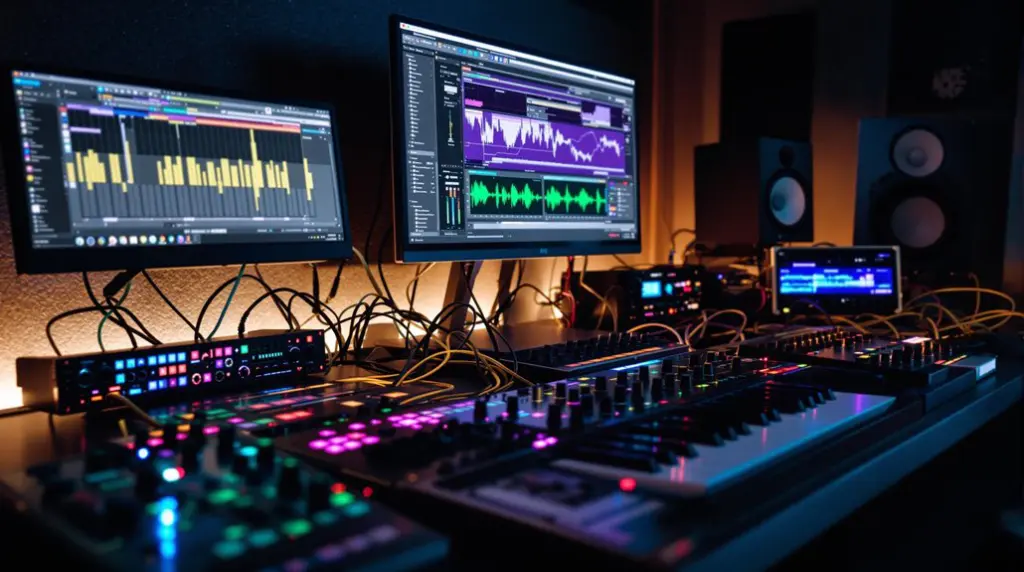To build your own DIY studio monitors, start by selecting high-quality drivers with a flat frequency response. Then, design an enclosure that considers internal volume and bracing, using double-walled birch plywood for low resonance. Accurately cut and assemble the wood panels, ensuring a sealed and rigid cabinet. Install acoustic dampening materials like rock-wool and foam to optimize sound clarity. Mount the drivers with an airtight seal and secure alignment. Finish with paint for protection, then calibrate using measuring equipment to fine-tune the sound. Follow these detailed steps to achieve professional-grade studio monitors. You’ll master the intricacies of each step next.
Key Takeaways
- Select high-quality drivers with flat frequency response and high sensitivity.
- Design the enclosure with proper volume, bracing, and separate chambers.
- Accurately cut and assemble wood panels, ensuring airtight seals and rigidity.
- Install acoustic dampening materials like rock-wool and foam for sound clarity.
- Test and calibrate the assembled monitors to fine-tune the output for desired sound quality.
Select Your Drivers
When selecting your drivers for DIY studio monitors, you’ll need to carefully consider specifications like frequency response and sensitivity to guarantee peak performance. Start by focusing on driver selection to ensure superior sound performance. Choose drivers that offer a flat frequency response, which is important for accurate sound reproduction. This means the drivers should produce consistent output across the entire frequency range without significant peaks or dips.
Next, evaluate the sensitivity requirements. Sensitivity, measured in decibels (dB), indicates how efficiently a driver converts power into sound. Higher sensitivity drivers require less power from your amplifier, contributing to better overall efficiency. Look for drivers with sensitivity ratings that match your amplifier’s output to avoid mismatched performance.
Additionally, select drivers made from high-quality materials such as carbon fiber or silk. These materials enhance transient response and clarity, providing crisp and precise sound. Ensure your chosen drivers complement each other across the frequency range for balanced sound output.
Lastly, compatibility with your amplifier and crossover system is essential. Ensure the drivers you select can integrate seamlessly to maintain excellent performance in your DIY studio monitors.
Design the Enclosure
Designing the enclosure requires meticulous attention to detail to guarantee excellent sound quality and minimized interference. Start by considering the internal volume for each driver. Manufacturers provide recommendations for peak performance, so adhere to these guidelines to avoid compromising sound quality. Ensuring driver compatibility with the enclosure’s volume and design is vital.
Construct the enclosure using double-walled birch plywood. This material reduces resonance and enhances durability. Internal bracing is also essential for minimizing unwanted vibrations, thereby maintaining the fidelity of the output.
Separate chambers for each driver are imperative to prevent interference and distortion. For the woofer, tune the enclosure volume carefully to achieve the desired low-frequency response. This tuning process involves adjusting the internal volume and shape, optimizing the woofer’s performance.
For the mid-range driver, angling the walls of its enclosure can significantly enhance sound dispersion and quality. This design choice helps distribute sound waves more evenly, improving the overall listening experience.
Each detail, from material selection to chamber separation, plays a pivotal role in the enclosure’s performance. By focusing on these aspects, you ensure the final product delivers exceptional audio quality.
Cut the Speaker Parts
With the enclosure design finalized, you need to measure and mark the wood panels accurately before cutting the speaker parts. Start by laying out your wood paneling on a flat, clean workspace. Use a pencil for marking; it guarantees precision without the risk of inaccuracy that a sharpie might introduce. Double-check all measurements to align perfectly with your speaker cabinet design.
Clamp the wood pieces together to maintain uniformity in size. This step is vital for ensuring the consistency of your cuts. For cutting the driver holes, a jigsaw or Dremel tool offers the precision required. Follow the marked outlines carefully to achieve smooth, exact cuts. Avoid rushing this process; the accuracy of these cuts directly impacts the overall performance of your DIY studio monitors.
After cutting, clean up any rough edges using sandpaper. This is part of essential finishing techniques that contribute to the professional look and durability of your speaker cabinet.
Always keep your workspace tidy to maintain precision and organization throughout the cutting process.
These design tips will help you achieve a high-quality build that enhances both the look and sound of your custom studio monitors.
Assemble the Cabinet
To assemble the cabinet, start by aligning the pre-cut MDF or plywood panels according to your design specifications. Guarantee each piece fits precisely to maintain the integrity of the structure. Use screws or strong wood glue for an airtight construction, important to prevent sound leakage. After assembling the main structure, install internal bracing to enhance rigidity and reduce vibrations, which improves sound quality.
Next, apply sealing techniques to make certain there are no gaps or leaks, which are necessary for airtight construction. Proper sealing ensures that the cabinet’s acoustic properties are maintained, providing a clear and accurate sound.
Here’s a simple guideline to follow:
| Step | Tools Needed | Description |
|---|---|---|
| Align Panels | Clamps, Square | Align MDF/plywood panels according to the design |
| Secure Panels | Screws, Wood Glue | Use screws or glue to secure panels |
| Install Bracing | Wood Bracing, Glue | Add internal braces for rigidity |
| Seal Edges | Caulk, Wood Filler | Seal gaps for an airtight construction |
| Finish Cabinet | Paint, Sandpaper | Apply cabinet finishing and painting |
Install Acoustic Dampening
Now, you’ll need to choose the right dampening materials and install them correctly. Rock-wool is a great option as it evenly dampens across the frequency spectrum and improves driver performance.
Make sure to properly stuff the rock-wool to reduce unwanted resonances and enhance sound clarity.
Choosing Dampening Materials
When choosing dampening materials for your DIY studio monitors, rock-wool stands out for its superior ability to reduce unwanted resonances and enhance sound clarity. Rock-wool is highly effective in dampening due to its fibrous nature, which slows down the speed of sound and minimizes resonances.
This material provides even acoustic treatment across the frequency spectrum, ensuring your monitors deliver accurate sound reproduction.
Consider these material options and placement techniques for best dampening effectiveness:
- Rock-wool Panels: Ideal for lining the interior walls of your monitors, these panels help eliminate standing waves and reduce reflections.
- Acoustic Foam: While not as effective as rock-wool, foam can be used in conjunction with it to further reduce high-frequency reflections.
- Fiberglass Insulation: Another option, fiberglass helps in dampening but may require careful handling due to its irritant properties.
For effective placement, position rock-wool strategically within the enclosure, ensuring it covers all walls to maximize dampening. Proper acoustic treatment involves not just the material but also its correct placement to enhance driver performance and minimize unwanted resonances.
Proper Installation Techniques
Although installing acoustic dampening material like rock-wool inside your speaker enclosure can seem challenging, ensuring the necessary steps guarantees excellent sound quality and performance.
Begin by measuring and cutting the rock-wool to fit snugly within your speaker’s interior. This guarantees even coverage and maximizes the material’s ability to absorb sound energy.
Next, position the rock-wool strategically to reduce unwanted reflections and standing waves. Place it on the interior walls of the enclosure, making sure there are no gaps. This precise acoustic treatment helps slow down the speed of sound, enhancing driver performance and providing a balanced frequency response.
To achieve effective soundproofing techniques, secure the rock-wool in place using non-resonant adhesives or mechanical fasteners. Avoid compressing the material too tightly, as this can diminish its effectiveness.
Properly installed, the acoustic dampening material will eliminate resonances, resulting in clearer and more detailed sound reproduction.
Mount the Drivers
When mounting the drivers, make sure they’re properly aligned and spaced for best sound dispersion. Use gaskets or foam rings to create an airtight seal, and securely fasten each driver with screws or bolts to prevent vibrations.
Follow the manufacturer’s recommendations for positioning and mounting depth, and test the drivers afterward to confirm functionality.
Driver Mounting Process
To mount the drivers correctly, make sure they’re centered and aligned within the speaker enclosure for peak sound performance. Proper driver alignment is essential to guarantee the best sound quality. Follow these steps to achieve an ideal setup:
- Position the Drivers: Carefully place each driver into its designated cutout. Make sure the drivers are centered to avoid any imbalance that could impact sound performance.
- Create an Airtight Seal: Use gaskets or foam seals between the driver and the enclosure. This will prevent any air leaks that could result in sound distortion. An airtight seal is crucial for maintaining the integrity of your speaker’s sound.
- Secure the Drivers: Fasten the drivers using screws or mounting brackets. Ensure they’re firmly in place to prevent any movement or vibrations during operation. Follow the manufacturer’s recommendations for the type and number of screws or brackets to use.
Double-check the driver orientation and spacing to avoid interference or phase cancellation between different drivers in your system.
Ensuring Secure Fit
Mounting the drivers securely guarantees that they remain stable and free from vibrations during operation, which is essential for maintaining sound quality. Begin by ensuring proper driver alignment. Center the drivers within the cutout holes in the speaker cabinet. This alignment is critical to avoid any misalignments that could distort the sound.
Next, use gaskets or sealing tape around the drivers to create an airtight seal. This sealing technique prevents air leaks, maintaining the integrity of your sound quality. Secure the drivers in place using screws or mounting brackets provided by the manufacturer. It’s important to use all the screws to ensure an even and snug fit.
Before finalizing the mounting, check for obstructions or misalignments. Ensuring everything is clear and correctly positioned will prevent any unwanted vibrations or sound disturbances. Lastly, double-check the polarity of the drivers. Correct polarity is essential for accurate sound reproduction.
Here’s a quick reference table to evoke the importance of each step:
| Step | Emotion |
|---|---|
| Center drivers | Precision |
| Use gaskets/sealing tape | Confidence |
| Secure with screws/brackets | Stability |
| Check for obstructions | Assurance |
Optimal Driver Positioning
After confirming a secure fit, position the woofer, mid-range driver, and tweeter vertically in the cabinet for peak performance and sound clarity. This vertical alignment is vital for accurate driver alignment, which directly impacts speaker performance.
Begin by placing the woofer at the bottom, the mid-range driver in the center, and the tweeter at the top. This configuration guarantees a smooth shift between frequencies, resulting in a balanced and coherent sound.
Follow these steps for best driver positioning:
- Mount the Woofer: Secure the woofer at the bottom of the cabinet. Make sure it’s firmly in place to prevent vibrations that could distort sound.
- Position the Mid-Range Driver: Place the mid-range driver above the woofer. Use gaskets or seals around the drivers to avoid air leaks and maintain the integrity of the speaker enclosure.
- Install the Tweeter: Mount the tweeter at the top of the cabinet. This heightens high-frequency dispersion and clarity.
Adhere to the manufacturer’s recommendations for each driver’s positioning. This ensures you’re maximizing the speaker’s performance potential.
Proper driver alignment and secure mounting will yield a speaker system with superior sound reproduction and minimal distortion, enhancing your DIY studio monitors’ overall quality.
Finish and Test
Applying a primer and paint finish to the speaker boxes not only gives them a professional look but also provides vital protection. Choose a color or design that reflects your style, enhancing both the aesthetics and customization of your DIY studio monitors. This step guarantees the longevity of the wooden surfaces and prepares them for the next critical phase.
To enhance sound quality, add solid dampening materials like foam or acoustic stuffing inside the speaker boxes. These materials absorb unwanted vibrations and improve the overall acoustics. Afterward, perform the final soldering of all components, making sure each connection is secure and reliable.
Connect the speakers to an amplifier and begin the calibration process. Use a reliable sound source and measuring equipment to fine-tune the output, ensuring your DIY monitors deliver accurate and balanced audio. Adjust the levels and crossovers as needed until you achieve the desired sound quality.
Once you’re satisfied with the sound, take a moment to appreciate the aesthetics and craftsmanship of your completed project. Not only have you built a set of functional studio monitors, but you’ve also gained valuable technical skills and a deeper understanding of audio engineering. Enjoy the satisfaction and the powerful sound you’ve created.
Frequently Asked Questions
How Are Studio Monitors Made?
To make studio monitors, you select drivers (woofers, midrange, tweeters) and construct precise cabinets. Focus on driver selection for accurate sound and cabinet construction to minimize resonances, ensuring proper signal distribution with amplifiers and crossover networks.
What Do I Need to Set up Studio Monitors?
To set up studio monitors, you’ll need an audio interface, cables, and proper cable management. Confirm that your room acoustics are optimized with treatments like bass traps and diffusers for the best sound quality and accurate mixing.
How Do You Set up a Monitor for a Home Studio?
To set up a monitor for a home studio, position it at ear level, use isolation pads, and angle it towards your listening position. Monitor placement and room acoustics are essential for minimizing reflections and optimizing sound quality.
Should Studio Monitors Be Vertical or Horizontal?
You should position studio monitors vertically for the best speaker orientation and acoustic placement. Vertical alignment preserves the intended frequency response and avoids phase cancellation, ensuring accurate sound reproduction and maintaining the stereo image and soundstage.
Conclusion
You’ve now got the blueprint to build your own DIY studio monitors. By carefully selecting your drivers, designing the enclosure, cutting the parts, assembling the cabinet, installing acoustic dampening, mounting the drivers, and finishing with thorough testing, you’ll create high-quality monitors tailored to your needs.
Precision at each step guarantees top-notch sound quality. Enjoy the satisfaction of producing professional-grade audio from your custom-built monitors. Your meticulous craftsmanship will truly make a difference in your listening experience.




